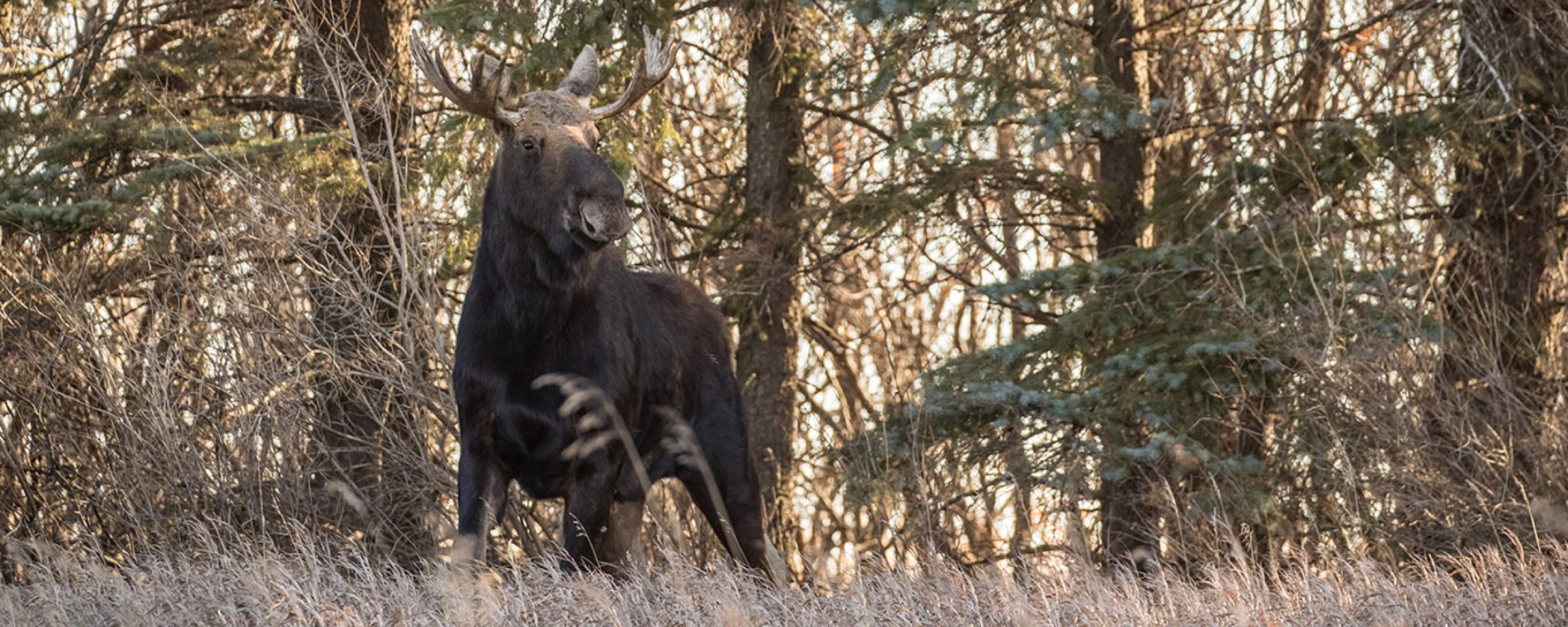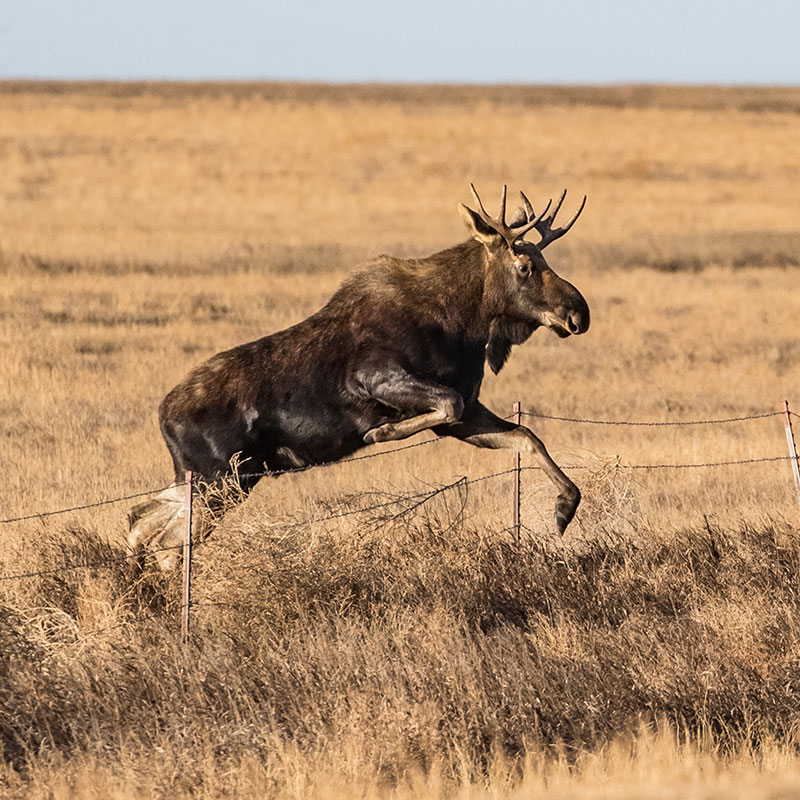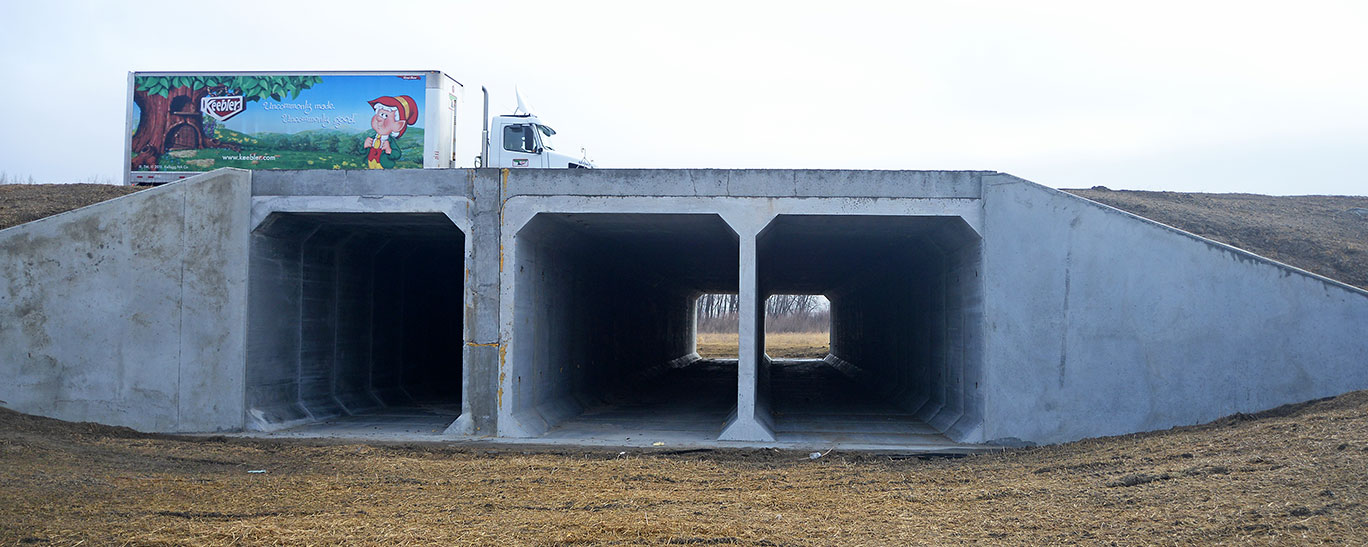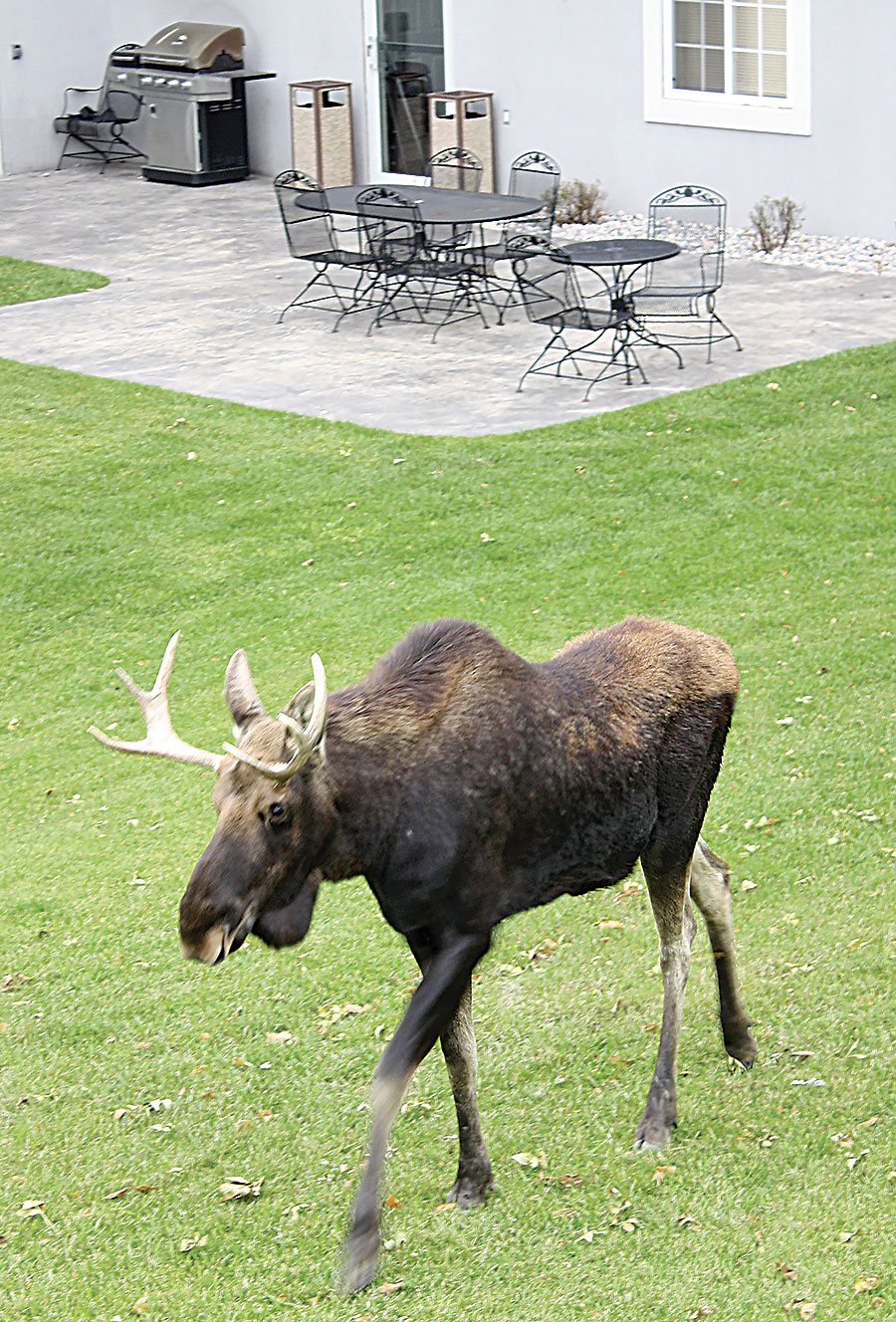
Moose Move West
Moose are on the loose in western North Dakota. From Dickinson to Anamoose, and Williston to Underwood – and even all the way down to Bismarck – moose are becoming a more common sight on the landscape. But that hasn’t always been the case.
North Dakota’s highest moose densities today are found in the northwestern part of the state.
The largest members of the deer family were rare to nonexistent in North Dakota in the early 1900s. They reappeared again in the 1950s, and by the 1960s, a small resident population was established in the Pembina Hills. As moose numbers grew, the animals also began to populate the Turtle Mountains and surrounding area. That northeast corner of the state remained the only region where moose were reliably found through the early 1990s.
The first hunting season for moose in North Dakota was 1977, when 10 licenses were awarded to hunters. Since then, the moose population has continued to grow, and the state has had a moose hunting season every year since that first season. In fact, the season has grown along with the population. Since 1985, the North Dakota Game and Fish Department has made at least 100 licenses available to hunters every year.
But that doesn’t mean the moose population has grown consistently across the state. In the last 12 years, moose numbers have declined in the Pembina Hills area. Aerial wildlife counts conducted by Game and Fish biologists note that about 250 moose were spotted in that region in 1995, but only two cow moose were observed in the survey areas flown in 2017.

The 2017 moose season in North Dakota featured another record number of once-in-a-lifetime licenses. The increase in license numbers was primarily in the northwest region of the state. Game and Fish issued 245 licenses for last fall’s hunting season.
Elsewhere in the state, however, moose numbers are increasing.
Moose began to increase in the western part of the state in the mid-2000s. The Anamoose and Lonetree Wildlife Management Area, Williston and Kenmare areas all have seen increases in moose populations since then, and the area with the highest moose density is no longer the Pembina Hills – it is now the Upper Missouri River area near Williston.
So why is the moose population seemingly moving west? Jason Smith, Game and Fish big game management biologist, said these 1,000-pound animals are being affected by a creature the size of a single hair.
“The primary reason for the decline in moose populations on the eastern side of the state is brain worm,” he said. “As you move west, the risk of transmission of brain worm drops off, and we’re seeing that same pattern in Canada.”
Brain worm, or the meningeal worm Parelaphostrongylus tenuis, is a parasite often found in white-tailed deer, and it’s spread through the deer’s feces.
Dr. James Maskey of the University of Mary said the worm larvae are picked up by snails or slugs, and those gastropods are then accidentally eaten by ungulates like deer as they graze. In whitetails, Maskey said the worms migrate through the deer’s body to the spinal column, and they travel along the outside of the spinal cord to the surface of the brain, where they survive, reproduce, and keep the cycle going. While it doesn’t pose significant health issues for whitetails, it may cause death in “accidental hosts” such as moose, elk and mule deer.
Maskey said in those animals, scientists believe the worms don’t receive necessary chemical cues to help them navigate the spinal column, and because of this, the worms burrow into the spinal cord, rather than along it; and into the brain stem and the brain itself, instead of traveling along the surface. The worms in the brain and spinal cord, and the resulting damage and inflammation caused by the moose’s immune response, cause neurologic problems that eventually lead to death.
The more moist climates in the eastern portions of the state are necessary for the slug and snail hosts of the brain worms to survive, Maskey said. Farther west, the climate tends to be more arid, and the snails and slugs can’t survive – and because of this, the brain worms aren’t spread from one animal to the next.
The worms themselves are only about two inches long, and they’re thin, Maskey said. “They’re about the width of a hair.” Yet despite the fact that they’re barely big enough to see, they’re able to push around one of the biggest animals in North Dakota.

Wildlife Under the Bridge
Wildlife ranges seldom are contained neatly on one side of a busy thoroughfare. More often, wild animals wander back and forth across a county road, state highway, or even an interstate.
This can lead to wildlife-vehicle collisions, which often result in property damage, human injury and wildlife deaths. And the larger the animal, the higher the probability that damage and injury will occur to vehicles and their occupants.
Near Williston, the 12,000-acre Lewis and Clark Wildlife Management Area is bisected by U.S. Highway 85. This highway has experienced an increase in vehicle traffic over the years, and to handle that traffic, the road was slated to be widened from two to four lanes in 2016.
To complicate matters, the wildlife crossing this stretch of highway is different than what you’d expect in other areas of North Dakota. In addition to the usual white-tailed deer, coyotes, turkeys and other common inhabitants of the state’s outdoors, the Williston area also has a large – and increasing – moose population.
“Widening Highway 85 means there’s a bigger barrier for wildlife to cross,” said Bruce Kreft, Game and Fish Department resource biologist. “It further fragments some of the most unique habitat in the state. It goes through a 2.5-mile flood plain, with a wildlife management area on both sides, and there’s an expanding moose population that uses the habitat on both sides of the road.”
And moose are big animals that can cause substantial damage to vehicles that strike them. When a passenger vehicle hits a 1,000-pound animal, especially one that can be nearly 7 feet tall, the damage isn’t always limited to the automobile. Accidents of this sort often result in bodily injury or even death.
“The impacts of hitting a moose are pretty dramatic to the vehicle and to the occupants, and certainly to the moose,” said Kent Luttschwager, Game and Fish wildlife resource management section leader in Williston. “So we needed to minimize that damage as best we could.”

Trail cameras installed by the Game and Fish Department captured images of moose using the wildlife underpass for the first time in late November.
Collision Course
While it’s a necessary route to move people from north to south and vice versa, the road travels through an important migration corridor for wildlife moving from the western side of the management area to the east, or from the east to the west.
“Fifteen to 25,000 vehicles a day through those flats is, I believe, what we are at or what we were projecting,” said Wayne Zacher, a transportation engineer with the North Dakota Department of Transportation.
With those numbers of vehicles crossing this migration corridor, wildlife-vehicle collisions are inevitable.
“We’ve had numerous moose documented killed in this general area,” Kreft said. “Several moose have been killed, and many, many white-tailed deer. Many go unreported because a lot of times they are hit with semis or larger vehicles, and those trucks just keep rolling.”
Cooperation is Key
A solution was needed to reduce the chances for injury or death to people and wildlife, and a number of agencies had a vested interest in the highway and the land it crossed.
“The Lewis and Clark Wildlife Management Area is owned by the U.S. Army Corps of Engineers,” Kreft said. “The North Dakota Game and Fish Department leases the land from them, and we manage it, but the corps is obviously a huge player in what goes on on their lands. The Federal Highway Administration was involved, as were the North Dakota Department of Transportation and the State Engineer’s Office. The U.S. Fish and Wildlife Service also was involved due to the potential impact it would have on endangered species – in this case the pallid sturgeon. So there were a lot of agencies involved, but we were able to have good discussions and came up with a good solution.”
Zacher said from the Department of Transportation’s perspective, the interagency cooperation was positive and productive.
“In order to come up with a viable plan, we had to have an open and honest dialogue, and we had that,” he said. “We went around and around about the size of the wildlife underpass, but we were able to come to an agreement. Having those open discussions was key to that agreement.”
The underpass dimensions measure 15 feet high and 40 feet wide, and the resulting tunnel stretches about 84 feet long under the road. Zacher said that size was decided on after many meetings between the various agencies, as well as site visits and peer exchanges with Montana agencies to look at similar structures in that state that are being used by wildlife, ranging in size from mink to moose.
The section of U.S. Highway 85 that crosses Lewis and Clark WMA splits habitat used by many species of wildlife, and those animals often travel from one side of the road to the other. Though all the agencies involved in the planning of the wildlife crossing may have had different reasons for wanting a safe way to get moose and other animals from one side of the road to the other, they all agreed that human safety was a main concern.
“The primary goal was to reduce the number of animal-vehicle collisions,” Zacher said. “The wildlife crossing is a win-win for everybody. People in vehicles are safer, and the animals themselves are safer.”
Fences and Funnels
Considering all the issues in the area, project planners knew a few wildlife crossing warning signs wouldn’t be enough. Signs warning of the possibility of wildlife in the roadway would alert drivers to the potential dangers, but warning signs aren’t always heeded. A fence keeping the animals off the road would only cause the crossings to occur in other places, and it would further fragment the habitat already broken up by the highway itself. And an underpass or an overpass to allow wildlife to safely cross might work, but only if the animals are conditioned to use the crossings.
The solution lay in a combination of these strategies. In conjunction with the underpass, the project included 3 miles of 6-foot-high wildlife fence along both sides of the road.
“(The underpass) is much like a normal bridge that you would see anywhere in the state of North Dakota,” Kreft said. “It is designed specifically to accommodate moose. It is large enough and wide enough that data has shown that it is going to be able to allow moose to pass through it. Although, with that being said, white-tailed deer, coyotes and any other animals are going to be able to use it.”
That’s one half of the strategy. The other half lies in “teaching” the animals that the underpass is a safe way to get from one side of the management area to the other.
“There is also a fence that is associated with it to funnel those animals to the road to try to keep them off the highway and prevent them from getting hit, and to direct them to the wildlife crossing,” Kreft said.
The underpass by itself may or may not be effective in providing a safe means of travel for the area’s wildlife, but the fence is a key factor in habituating the animals to cross under the highway.
“We needed an area where we had a lot of wildlife use and a lot of wildlife crossing,” Luttschwager said. “But we also needed to direct them to that. And one of the things in conjunction with this project is a high game fence. (The animals) are going to have to follow that fence until they get to the wildlife crossing to cross to the other side.”
The underpass was completed in October 2017, and its concrete floor was covered with more than a foot of dirt to make the path appealing to wild animals. Though the fence wasn’t finished until December, the sections that were completed immediately started funneling animals toward the underpass and to the smaller three-culvert passage farther south. Cameras were installed by the Game and Fish Department in November to monitor the crossing and to determine its effectiveness. Within a week of the cameras being activated, Game and Fish employees were excited to see a moose disappearing into the tunnel, and judging by the early camera footage, the fence and underpass seem to be working.
“It is a win-win,” Kreft said, echoing Zacher’s statements. “Numerous agencies have come together to try to address the issue of safety on the road both for traffic volume and for animal-vehicle collisions. For us, we are getting an opportunity to get those animals across the road safely. For the Department of Transportation, it is an opportunity for their mission to provide a safe roadway.”
Dealing with Moose Encounters
The key to coexisting with moose is to avoid confrontations by giving moose plenty of space.
If you see a moose in an urban setting, do not approach it and call local authorities. If a moose is near a school, stay inside until properly trained responders safely herd the animal away.
In a rural setting such as a farm yard, give the moose space and time to wander away on its own, and call local authorities if you feel it is a danger.

A moose wanders through a residential back yard in North Dakota.
Avoid Feeding Moose
When moose wander into farm yards or urban areas during winter, it might be tempting to provide a hand-out if these animals look like they are struggling. But feeding moose, or any wild animal for that matter, almost always does more harm than good. Moose fed by humans tend to lose their healthy fear of man, and they may hastily approach the next unsuspecting person they encounter.
Moose and Crops
Moose are mostly browsers and do not typically eat hay or other foods meant for cattle. But they are adaptable and at times will eat standing crops such as sunflowers or soybeans. If they hang around in one place for an extended period, they can cause crop damage.
In such cases, the Game and Fish Department may be able to direct licensed hunters to landowners experiencing crop damage. The Department’s private lands program may also be able to provide technical assistance to private landowners to help minimize crop depredation, or work with landowners to develop wildlife food plots specifically intended for depredation purposes. To find out more about crop damage prevention measures, contact the Game and Fish Department at 701-328-6300.
Moose-vehicle Collisions
In parts of North Dakota, moose are common enough that collisions with vehicles sometimes occur. When driving in moose country, especially in the winter, slow down. If a moose moves into the path of your vehicle, stop as quickly as you safely can, but don’t swerve. Swerving may cause you to lose control of your vehicle.
The Bottom Line
Most people in North Dakota enjoy seeing moose, and it is a good thing that their population is expanding. It’s important to remember that they are wild animals and should only be observed from a distance.
